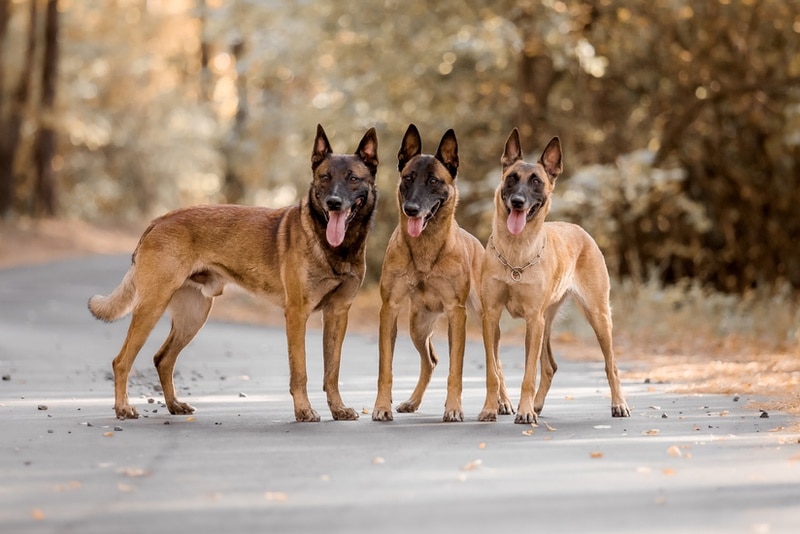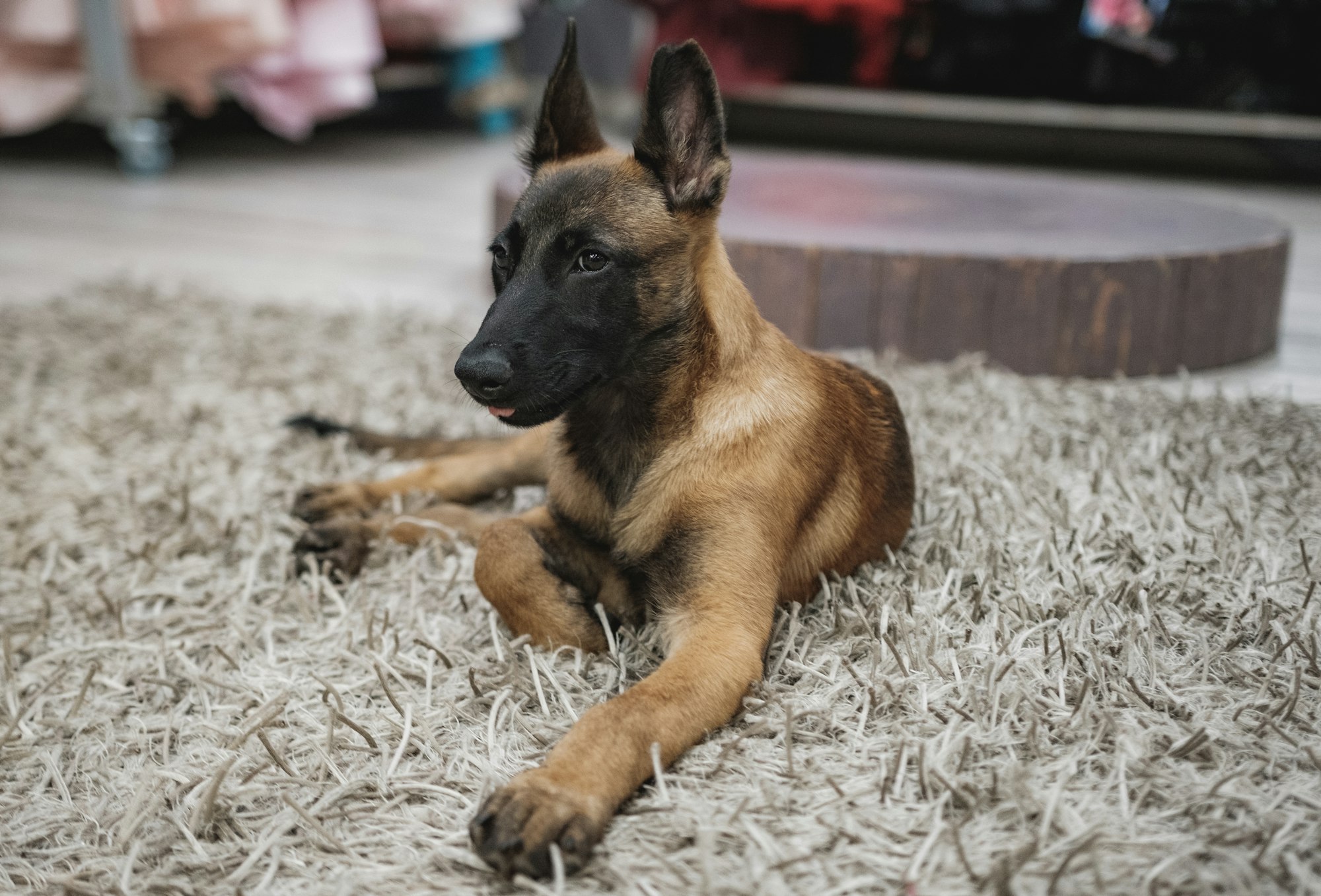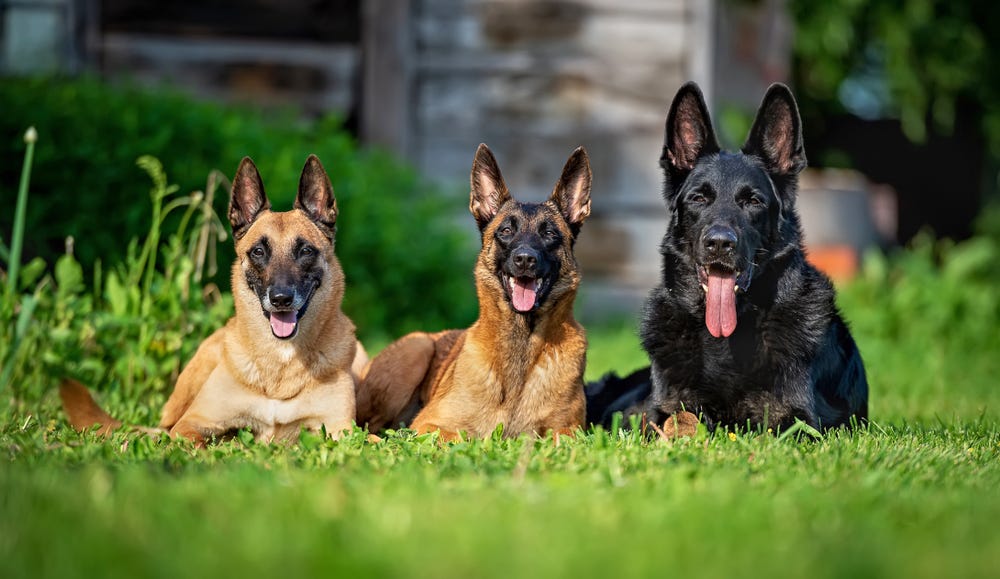Belgian Malinois is a breed of dog that is known for its intelligence, athleticism, and loyalty. They are often used as police dogs, military dogs, and search and rescue dogs. However, many people also keep them as family pets. One of the common questions that arise when considering a Belgian Malinois is whether they get along with other dogs.

Belgian Malinois can get along with other dogs if they are socialized properly. Socialization is the process of introducing a dog to different people, animals, and environments to help them become well-adjusted and confident. It is important to start socializing with a Belgian Malinois at a young age and to continue it throughout their life. However, it is essential to note that Belgian Malinois can be territorial and protective, which can lead to aggression towards other dogs if they feel threatened or perceive them as a threat.
Understanding Belgian Malinois
Belgian Malinois, also known as Belgian Shepherds, are a breed of herding dogs that originated in the city of Malines in Belgium. They are a part of the herding group and are known for their intelligence, loyalty, and versatility. Belgian Malinois are often used as working dogs by law enforcement agencies, military forces, and search and rescue teams due to their high energy levels and strong work ethic.
Belgian Malinois are protective of their owners and their families, which can sometimes make them wary of strangers and other dogs. They are highly intelligent and require a lot of mental and physical stimulation to keep them happy and healthy. Belgian Malinois is not recommended for first-time dog owners or those who do not have the time and energy to devote to their training and exercise needs.
As a breed, Belgian Malinois are known for their strong herding instincts and their ability to work independently. They are highly trainable and excel in activities such as obedience, agility, and tracking. Belgian Malinois are also known for their athleticism and have been known to participate in sports such as flyball, dock diving, and frisbee.
While Belgian Malinois can be socialized to get along with other dogs when they are young, they can sometimes be protective of their territory and their owners, which can lead to aggression towards other dogs. It is important to socialize Belgian Malinois early and to provide them with plenty of positive reinforcement for appropriate behavior around other dogs.
Overall, Belgian Malinois are a loyal and intelligent breed that requires a lot of attention and training to keep them happy and healthy. They are not recommended for first-time dog owners or those who do not have the time and energy to devote to their exercise and training needs.

Belgian Malinois Temperament
Belgian Malinois are known for their active, intelligent, and loyal temperament. They are highly energetic and need plenty of exercise and mental stimulation to keep them happy and healthy. This breed is also very alert and has a high level of intelligence, making them excellent watchdogs.
While Belgian Malinois are often friendly towards their family members, they can be suspicious of strangers and may require socialization and training to prevent aggression towards unfamiliar people. They are also highly protective of their owners and may exhibit jealousy towards other dogs or people who try to interact with them.
If left unsupervised or without enough physical and mental stimulation, Belgian Malinois can become destructive and engage in undesirable behaviors like chewing and digging. Therefore, it is important to provide them with plenty of exercise, training, and attention to keep them happy and well-behaved.
Overall, Belgian Malinois have a strong and confident personality that requires an experienced and knowledgeable owner who can provide them with the care and attention they need. With proper socialization and training, they can be excellent companions and watchdogs.
Physical Characteristics of Belgian Malinois
Belgian Malinois is a medium-sized dog breed that is well-muscled and has a square build. The average height of a male Belgian Malinois is between 24 to 26 inches, while females are between 22 to 24 inches tall. The weight of a male Belgian Malinois ranges from 60 to 80 pounds, while females weigh between 40 to 60 pounds.
The Belgian Malinois has a short, smooth double coat that is weather-resistant. The coat colors can be fawn, mahogany, red, red sable, or fawn sable with a black mask. The coat is easy to maintain, and regular brushing will help keep it shiny and healthy.
The Belgian Malinois has a strong and sturdy body with a broad chest and well-developed muscles. They have a wedge-shaped head with erect ears that are triangular in shape. The ears are set high on the head and are proportionate to the size of the dog. The eyes are almond-shaped, and the color can range from brown to dark brown.
The Belgian Malinois has a powerful and athletic body that is built for endurance and agility. They have a deep chest, strong legs, and a long tail. The tail is set low and tapers to a point. The feet are compact and have strong, arched toes.
In conclusion, the Belgian Malinois is a well-built and muscular dog breed with a short, smooth double coat that is easy to maintain. They have a wedge-shaped head with erect ears and almond-shaped eyes. The breed is athletic and built for endurance and agility, making them excellent working dogs.
Belgian Malinois and Socialization
Belgian Malinois are known for their loyalty and protectiveness towards their owners. However, this breed may not always get along with other dogs. It is important to socialize your Belgian Malinois from a young age to ensure that they can coexist peacefully with other dogs.
Socialization involves exposing your dog to different environments, people, and other animals. This helps them learn appropriate behavior and communication skills. It is crucial to socialize your Belgian Malinois with other dogs to prevent aggression towards other dogs.
One way to socialize your Belgian Malinois is to take them to dog parks. This allows them to interact with other dogs in a controlled environment. However, it is important to supervise your dog and make sure they are playing appropriately. If your Belgian Malinois shows signs of aggression, remove them from the situation immediately.
Another way to socialize your Belgian Malinois is to enroll them in obedience classes. This allows them to learn basic commands and interact with other dogs in a structured setting. It is important to choose a reputable trainer who has experience working with Belgian Malinois.
Overall, socialization is key to ensuring that your Belgian Malinois can get along with other dogs. By exposing them to different situations and environments, you can help them develop appropriate behavior and communication skills.
Belgian Malinois Interaction with Other Dogs
Belgian Malinois are intelligent and energetic dogs that can make great companions. However, their compatibility with other dogs can be a concern for potential owners. While some Belgian Malinois can get along well with other dogs, others may not.
The interaction between Belgian Malinois and other dogs highly depends on how they are introduced and socialized. Proper introduction and socialization can improve the chances of a Belgian Malinois getting along with other dogs.
It is important to note that Belgian Malinois can be protective of their family, especially their owner. This can make them very jealous and territorial, which can lead to aggression towards other dogs.
When introducing a Belgian Malinois to other dogs, it is important to keep a close eye on their interactions, especially during the early stages of their relationship. Supervision can help ensure that both dogs feel safe and secure in each other's company.
Belgian Malinois may also have a tendency to be dominant towards small dogs. It is important to consider the size and temperament of the other dog when introducing them to a Belgian Malinois.
In summary, Belgian Malinois can get along with other dogs, but proper introduction and socialization are key. Owners should be aware of their protective nature and supervise interactions between their Belgian Malinois and other dogs, especially small ones.

Training a Belgian Malinois
Belgian Malinois are highly intelligent and trainable dogs. They require consistent and firm training from an experienced trainer. Obedience training should start at a young age, ideally around 10 weeks old. Positive reinforcement is the most effective method for training a Belgian Malinois.
A trainer should establish themselves as the alpha in the relationship to prevent the dog from becoming dominant. Consistent and fair discipline is necessary to establish boundaries and prevent destructive behavior. Belgian Malinois thrive in environments with structure and routine.
Training should focus on basic commands such as sit, stay, come, and heel. Once these commands are mastered, more advanced training can begin. Belgian Malinois excels in obedience, agility, and protection training.
It is important to note that Belgian Malinois have a high energy level and require daily exercise. A lack of exercise can lead to destructive behavior. Training sessions should be kept short and engaging to prevent boredom.
Overall, training a Belgian Malinois requires patience, consistency, and experience. With proper training, a Belgian Malinois can be a well-behaved and obedient companion.
Belgian Malinois Energy and Exercise Needs
Belgian Malinois are known for their high energy levels and their need for regular exercise. They are a working breed that was originally bred for herding and guarding livestock. As a result, they have a lot of energy and require plenty of physical and mental stimulation to stay healthy and happy.
The Belgian Malinois is a very active breed that requires a lot of exercise. They need at least an hour of physical activity every day to stay healthy. This can include activities like running, hiking, and biking. They also enjoy playing games like fetch and tug-of-war.
In addition to physical exercise, Belgian Malinois also need mental stimulation. They are highly intelligent dogs that require mental challenges to keep them engaged. This can include activities like training, puzzle toys, and dog sports like agility and obedience.
It is important to note that Belgian Malinois are not a breed that can be left alone for long periods of time. They require a lot of attention and interaction with their owners. They thrive in environments where they can be active and engaged with their humans.
Overall, the Belgian Malinois is a high-energy breed that requires plenty of exercise and mental stimulation to stay healthy and happy. They are a great choice for active families who are willing to provide them with the time and attention they need.

Belgian Malinois as Family Dogs
Belgian Malinois are often used as working dogs in law enforcement and the military due to their intelligence, trainability, and protective nature. However, they can also make great family pets when properly trained and socialized.
When it comes to living with other dogs, Belgian Malinois can be dominant and territorial. They may not get along with other dogs, especially those of the same sex. Early socialization and proper training can help prevent aggression towards other dogs.
Belgian Malinois are also known for their high energy levels and need for exercise. They require daily physical and mental stimulation, such as long walks, runs, and interactive playtime. This makes them a good fit for active families who enjoy spending time outdoors and have the time and resources to provide for their needs.
When it comes to living with children, Belgian Malinois can be affectionate and playful. They have a strong protective instinct and may be wary of strangers, making them good watchdogs. However, their high energy levels and strong prey drive may make them unsuitable for families with young children or small pets.
Overall, Belgian Malinois can make great family pets for those who are willing to put in the time and effort to properly train and socialize them. They are intelligent, loyal, and protective, but also require a lot of attention and exercise. Families considering a Belgian Malinois should carefully evaluate their lifestyle and ability to provide for the dog's needs before making a decision.
Belgian Malinois and Their Protective Nature
Belgian Malinois are known for their protective nature towards their owners and their territory. They are naturally protective and make excellent protection dogs. Their strength, fearlessness, fierceness, and diligence make them the perfect guard dogs.
When it comes to other dogs, Belgian Malinois can be territorial and may not get along with other dogs easily. They may become aggressive towards other dogs, especially if they feel that their territory is being threatened. It is important to socialize them from a young age to prevent any aggression toward other dogs.
Belgian Malinois are also known to be protective of their human companions. They are loyal and will do whatever it takes to protect their owners from any potential danger. They are quick to alert their owners in case of any intruders and may even attack if the intruder gets too close.
It is important to note that while Belgian Malinois are naturally protective, they should not be trained to be excessively aggressive. Aggressive behavior can be dangerous and can lead to serious consequences. It is important to train them to be protective while still being able to distinguish between a real threat and a non-threatening situation.
Overall, Belgian Malinois are naturally protective and make excellent protection dogs. However, it is important to socialize them from a young age and train them to be protective without being excessively aggressive.
Health Considerations for Belgian Malinois
Belgian Malinois are generally healthy dogs with a lifespan of 12-14 years. However, like all breeds, they can be prone to certain health issues. It is important for potential owners to be aware of these issues and to take steps to prevent them.
One common health problem in Belgian Malinois is hip dysplasia. This is a genetic condition where the hip joint does not form properly, leading to arthritis and pain. To reduce the risk of hip dysplasia, it is important to buy from a reputable breeder who screens their dogs for this condition. Regular exercise and maintaining a healthy weight can also help prevent hip dysplasia.
Another health concern for Belgian Malinois is progressive retinal atrophy (PRA). This is a degenerative eye disease that can lead to blindness. There is no cure for PRA, but it can be detected through genetic testing. It is important for breeders to screen their dogs for PRA and for owners to have their dogs tested if they suspect they may be affected.
Belgian Malinois are also prone to certain skin conditions, such as allergies and dermatitis. Regular grooming and bathing can help prevent these conditions. It is also important to use high-quality dog food and to avoid feeding your dog table scraps or other human food.
The American Belgian Malinois Club recommends that all Belgian Malinois be screened for hip dysplasia, elbow dysplasia, and PRA. They also recommend that dogs be tested for brucellosis, a bacterial infection that can cause infertility in both males and females.
Overall, Belgian Malinois are generally healthy dogs, but it is important for owners to be aware of potential health issues and to take steps to prevent them. Regular veterinary check-ups and preventative care can help keep your Belgian Malinois healthy and happy for years to come.

Belgian Malinois in Professional Roles
Belgian Malinois are highly intelligent and versatile dogs that excel in various professional roles. Their loyalty, trainability, and strong work ethic make them an excellent choice for jobs that require physical strength, agility, and intelligence. Here are some of the professional roles in which Belgian Malinois are commonly employed:
Military and Law Enforcement
Belgian Malinois are often used as military and law enforcement dogs due to their intelligence, strength, and loyalty. They are trained to detect explosives, drugs, and other contraband, as well as to track and apprehend suspects. They are also used in search-and-rescue missions, where their keen sense of smell and agility can be invaluable.
Service Dogs
Belgian Malinois are also used as service dogs for individuals with disabilities. They can be trained to assist with tasks such as opening doors, retrieving objects, and providing support for individuals with mobility issues. Their protective nature and loyalty make them excellent companions for individuals with disabilities.
Pros and Cons
While Belgian Malinois are highly capable and intelligent dogs, they may not be the best fit for every situation. Here are some of the pros and cons of using Belgian Malinois in professional roles:
Pros
- Highly intelligent and trainable
- Strong and agile
- Loyal and protective
- Excellent sense of smell
Cons
- Can be wary of strangers and unfamiliar dogs
- May be aggressive if not properly trained and socialized
- Require a lot of exercise and mental stimulation
- May not be suitable for inexperienced dog owners
Overall, Belgian Malinois are highly capable dogs that can excel in a variety of professional roles. However, it is important to carefully consider their temperament and training needs before employing them in these roles.
Choosing a Belgian Malinois
When considering getting a Belgian Malinois, it is important to take into account their temperament and how they interact with other dogs. While most dogs can learn to get along with other dogs, some breeds tend to be more dog-friendly than others. Belgian Malinois are known to be fiercely loyal and protective of their family, which can sometimes lead to aggression towards other dogs.
If you are considering getting a Belgian Malinois puppy, it is crucial to socialize them early on with other dogs to help them learn appropriate behavior. This can be done through puppy classes or play dates with other well-behaved dogs. It is also important to provide consistent training and boundaries to ensure that the puppy understands what is expected of them.
When looking for a breeder or rescue, it is important to find one that prioritizes socialization and temperament testing. A reputable breeder or rescue will work to ensure that their dogs are well-behaved and have a good temperament before placing them in a new home.
It is important to note that owning a Belgian Malinois requires a significant commitment. They are high-energy dogs that require daily exercise and mental stimulation. Without proper exercise and training, they can become destructive and develop behavioral issues. It is important for owners to be knowledgeable and confident in their ability to provide for the needs of a Belgian Malinois.
In summary, while Belgian Malinois can be great companions, it is important to carefully consider their temperament and how they interact with other dogs before bringing one into your home. Socialization, training, and a commitment to meeting their needs are key factors in ensuring a happy and healthy relationship with a Belgian Malinois.

Belgian Malinois and Other Breeds
Belgian Malinois are known to be highly intelligent and loyal dogs. However, when it comes to getting along with other breeds, it can depend on the individual dog's personality and how they were socialized.
Generally, Belgian Malinois can get along well with other dogs, including breeds such as German Shepherds, Golden Retrievers, and Border Collies. However, it's important to introduce them properly and supervise their interactions, especially if one or both dogs are not neutered.
It's worth noting that Belgian Malinois have a strong prey drive, which can make them less compatible with smaller breeds like Beagles. They may see smaller dogs as prey and be more likely to chase or attack them.
When introducing a Belgian Malinois to another breed, it's best to do so on neutral ground, such as a park or a friend's backyard. This can help prevent territorial behavior and give both dogs a chance to get to know each other without feeling threatened.
In summary, Belgian Malinois can get along well with other breeds, but it's important to socialize them properly and supervise their interactions. Owners should also be aware of their dog's prey drive and take precautions when introducing them to smaller breeds.
Conclusion
Belgian Malinois are known to be highly intelligent, loyal, and protective dogs. When it comes to their behavior towards other dogs, they can be friendly and sociable as long as they are properly trained and socialized from an early age.
While there may be some individual differences in temperament, Belgian Malinois are generally good with other dogs when they receive basic obedience training and socialization. They have naturally friendly personalities and can get along well with multiple pets, including cats, chickens, and family dogs.
It is important to note that Belgian Malinois are a high-energy breed and may not be a good fit for households with small children or elderly individuals. They require plenty of exercise and mental stimulation to stay happy and healthy and may become destructive if they do not receive enough attention and activity.
Overall, Belgian Malinois can be great companions for families who are willing to invest time and effort into their training and care. With proper socialization and training, they can coexist peacefully with other dogs and make loyal and loving pets.
Frequently Asked Questions
What is the best companion dog for a Belgian Malinois?
Belgian Malinois can get along with other dogs, but they tend to be more compatible with breeds that share their energy levels and temperament, such as German Shepherds and Labrador Retrievers.
Can Belgian Malinois be family dogs?
Belgian Malinois can make great family dogs if they are properly trained and socialized. They are loyal, protective, and affectionate towards their owners, but they can be wary of strangers.
How can I socialize my Belgian Malinois with other dogs?
Socialization is crucial for a Belgian Malinois to get along with other dogs. It is recommended to start socializing them at a young age and to expose them to different environments, people, and dogs. Gradually increase the duration and intensity of socialization sessions to prevent overwhelming the dog.
Are Belgian Malinois good with cats?
Belgian Malinois have a strong prey drive and may view cats as potential targets. However, with proper socialization and training, they can learn to coexist with cats in the same household.
Are Belgian Malinois good with kids?
Belgian Malinois can be good with kids if they are raised with them from a young age and trained to interact with them appropriately. However, they can be high-energy and may accidentally knock over small children.
Who should not own a Belgian Malinois?
Belgian Malinois are not suitable for inexperienced dog owners or those who cannot provide them with the necessary exercise, training, and socialization. They are also not recommended for households with small children or other small pets.




